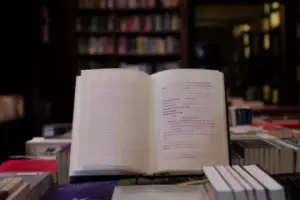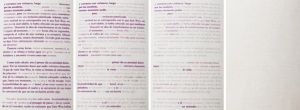by Jas Faulkner
 Anyone with a tall “to be read” stack will get chills at the thought of “El Libro que No Puede Esperar” (translation: “The Book That Can’t Wait”). Eterna Cadencia, a publisher and bookseller in Argentina, has reportedly published a collection of stories by up and coming Latin American writers featuring a gimmick that garnered the imprint a lot of attention outside of its usual market. In the interest of creating a sense of urgency that these authors should be read, and read soon, a promotional video reports they have printed the books using an ink that begins to degrade as soon as the book is exposed to air and light. Break the seal and you have two months to read the book. The fading process starts immediately.
Anyone with a tall “to be read” stack will get chills at the thought of “El Libro que No Puede Esperar” (translation: “The Book That Can’t Wait”). Eterna Cadencia, a publisher and bookseller in Argentina, has reportedly published a collection of stories by up and coming Latin American writers featuring a gimmick that garnered the imprint a lot of attention outside of its usual market. In the interest of creating a sense of urgency that these authors should be read, and read soon, a promotional video reports they have printed the books using an ink that begins to degrade as soon as the book is exposed to air and light. Break the seal and you have two months to read the book. The fading process starts immediately.
The promotional video about the book that has gone viral (en Inglés, gracias a Dios!). Mainstream outlets such as Wired and Huffington Post have already reported the story as gospel.
 The statement on the video from Eterna Cadencia offers the rationale that an author whose work is allowed to sit unread will fall between the cracks where the publishing industry is concerned. By creating a book with ink that completely disappears within two months, it is hoped that those who buy it will feel compelled to read what they have to say right away instead of years from now when the author has been forgotten by the industry and may have moved away from writing altogether.
The statement on the video from Eterna Cadencia offers the rationale that an author whose work is allowed to sit unread will fall between the cracks where the publishing industry is concerned. By creating a book with ink that completely disappears within two months, it is hoped that those who buy it will feel compelled to read what they have to say right away instead of years from now when the author has been forgotten by the industry and may have moved away from writing altogether.
I contacted a friend in San Diego whom I felt sure would be intrigued enough to get a copy of the book. While he has seen the coverage of “El Libro que No Puede Esperar” on various new media outlets, he is pretty sure the whole thing is an elaborate joke.
“Go to the publisher’s website,” he said, “I know your vocabulary is limited to kitchen Spanglish and Shakira lyrics, but go see what the publisher has to say about the book on their own website.”
If you haven’t visited Eterna Cadencia’s homepage yet, I will warn you that it is a book lover’s delight. The home page has shelf porn that sidetracked me for at least a few minutes (“Ooh! Pretty!”) They also have a wonderful blog and their selection is intriguing. I wish my Spanish was better. I browsed their rather lovely site and found…nothing about “El Libro que No Puede Esperar“. A search of the site’s blog was just as productive.
 Andrew laughed when I called him back.
Andrew laughed when I called him back.
“Told you,” he said. “As a marketing ploy and as a piece of performance art with a message, I like it, but no, it’s not real in the sense that you’d be able to buy a copy at Amazon. Yes, I checked there back in June when I first heard about it.”
Aside from the message it sends about the fragility of creative life in a culture that doesn’t value art as a vocation, there is the ephemeral quality of language. We like to think it’s eternal and immutable and it’s changing all the time. The same goes for any art form. The immediacy with which it speaks to us only lasts for so long and then we filter everything through our own canonical points of reference based on who and when we are.
 Anyone who puts paint on a canvas or words on a screen knows the odd feeling that we may not find an audience who eagerly seeks out what we do until we are gone. Culture observers may look on with bemusement and collectors in this country who have declared the desire for multiple copies may at some point get their wish. Personally, I can think of too many instances where I was saddened and frustrated by annotations of ancient texts noting gaps where the physical media was missing or untranslatable.
Anyone who puts paint on a canvas or words on a screen knows the odd feeling that we may not find an audience who eagerly seeks out what we do until we are gone. Culture observers may look on with bemusement and collectors in this country who have declared the desire for multiple copies may at some point get their wish. Personally, I can think of too many instances where I was saddened and frustrated by annotations of ancient texts noting gaps where the physical media was missing or untranslatable.
Literatura con una fecha de caducidad? No, gracias!


That was a frightening thought for awhile there. I have to-be-read piles going back to, well, ancient times. They’d all be blank. But I get the idea, it is obviously better for the artist for his work to be seen in real time. And when I was a bookseller, I read the newest of the new before the books were published. Now, I read what I want, when I want, and it can be a decade old.
Agreed. My other thought was that deadlines and expiration dates would go a long way towards sapping the pleasure out of reading.
Oneother thing that really jumped out at me was how everyone was passing this story along and yet no one seemed to have attempted to contact Eterna Cadencia or tried to find anyone who had a copy of the book. I checked with family and Argentina and Panama and some booksellers I know in the US who specialise in Latin American books. They’d seen the stories but have never seen the book itself.
Here is a rough translation of the letter I sent to Eterna Cadencia:
Hello!
I am a writer for a Canadian website called The Bookshop Blog. I am intrigued by a promotional video for “El Libro que No Puede Esperar” and was wondering if it was intended to serve as a very creative commentary on the fragility of creative life and how vulnerable writers are to the whims of the marketplace.
It seems that a number of online news outlets in North Americaare accepting the premise of the video without asking for more information and it is being treated as fact without further substantiation. If this is indeed a real publishing event, please accept my apology. I do not intend to offend. I am curious if this is an elegant statement that has somehow gotten twisted into acceptance as gospel truth in North America.
Presumptive thanks for your attention to my inquiry.
Sincerely,
Jas Faulkner
We’ll see if and how they respond. 🙂